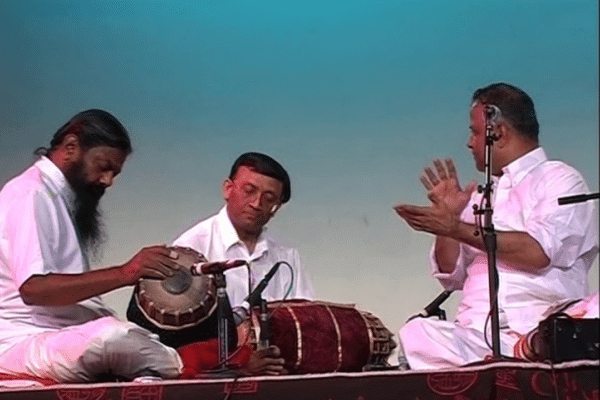Our Terms & Conditions | Our Privacy Policy
Ravi Ravichandhira OAM : Seven Notes of the Noted
Reading Time: 4 minutes
Ravi Ravichandhira’s passion for the development of Indian arts in Australia has led to the establishment of the high profile annual Indian Performing Arts Convention (IPAC) in consortium with Monash University Performing Arts Centres and Apsara Arts Singapore. He is acclaimed for integrating South Indian art into the Australian music scene, collaborating with diverse musicians including members of the Australian Art Orchestra and Indian stalwarts such as Kaaraikkudi Mani, and has played a key role in fostering new collaborations both in Australia and internationally.
What is the future of Indian classical arts in Australia compared to other countries?
Ravi Ravichandhira: Unlike 42 years ago when I arrived in Australia, today a thriving ecosystem exists amidst a growing South Asian diaspora in Australia, offering an ideal foundation for cross cultural works. Independent organisations nurture and uphold pure Carnatic traditions with the involvement of second and third generations today. Over the past four years, AIMCS in partnership with Apsaras Arts Singapore and Monash University Performing Arts Centres, has launched IPAC performance industry programs for next gen, involving mentorship and lec-dems from top-class Carnatic professionals of Australia and India. Today artists can engage with luminaries in the field.
(Source: Supplied)
How has receiving the Order of Australia Medal (OAM) impacted your work in this field?
Ravi Ravichandhira: Receiving the Medal has given recognition to a lifelong dedication to the arts. The award has been a catalyst to improved access enabling direct engagement with renowned artists and stakeholders in the arts sector, increased recognition for my work in Australia and abroad. That said, the OAM status does not grant any automatic privilege or right to funding.
Your views on how Australia’s festival and program funding models compare to others, in general?
Ravi Ravichandhira: Grant applications should be assessed strictly on merit, but assessors often lack the expertise to evaluate applications from diaspora communities. Without critique by qualified experts, poor funding decisions persist. There is a tendency to fund glamorous projects, over long-term works requiring years to mature.
Unlike festivals such as Cleveland, Margazhi, and Jaipur Lit Fest, Australia lacks Indo-Australian funding, private sponsorships and philanthropic support, all crucial for classical arts development.
Privately funded projects, such as those by Guru Kaaraikkudi Mani, took 5–10 years to cultivate. I introduced Mani Sir to esteemed jazz musicians like Paul Grabowsky AO, Sandy Evans PhD (Music), and Dr. Jonathan Dimond, PhD (Music). Similarly, Bharatanatyam exponent Rajeswari Sainath PhD and her student Vaishnavie PhD spent over five years mastering laya principles, achieving groundbreaking footwork while preserving expression and abhinayam.
 IPAC Australia 2023 (Source: Supplied)
IPAC Australia 2023 (Source: Supplied)
Tell us about your two sons’ trajectory in Carnatic arts.
Ravi Ravichandhira: My sons Sai-Nivaeithan and Sai-Sarangan Ravichandhira, have been playing mridangam spanning 18 years from the age of 12. They are consistently performing at the prestigious Margazhi Utsavam in Chennai. They have benefited from the mentorship of Guru Kaaraikkudi Mani, principally in helping raise their performing standards. Other Indian legendary artists have also guided my sons.
List some of your most successful Indo-Australian ventures.
Ravi Ravichandhira: Amidst many, foremost would be the Indian Music Tour of Australia and NZ (2001), a percussion ensemble, curated by me, in which I also performed, featuring the late Ustad Zakir Hussain and legendary Ghatam maestro Vikku Vinayakram. This remarkable tour took place at three mainstream arts centres in Auckland, Melbourne and Sydney.
The tour also showcased exceptional talents of Mandolin wizard U. Shrinivas, his brother U. Rajesh, and violinist Vidwan S. D. Sridhar, creating a mesmerising blend of melody and rhythm.
The other two ventures have to be Lalgudi’s Melodies (2015), a suite of DVDs and CDs, blending Bharatanatyam jathis and compositions, created in collaboration with my wife Narmatha Ravichandhira OAM, and the dance musical production Nature, the Great Teacher – A Dance Musical (2018) conveying an environmental message.
 Ravi along with Narmatha and Consul General of India in Melbourne Dr Sushil Kumar (Source: Supplied)
Ravi along with Narmatha and Consul General of India in Melbourne Dr Sushil Kumar (Source: Supplied)
What advice would you have for young mridangists?
Ravi Ravichandhira: Other than mastering rhythmic precision, clarity in fingering, focus on learning to complement whilst accompanying, cultivate manodharma, develop stage experience, and collaboration. Understand instrument chemistry, correct posture, reverence for Gurus. Active listening and engagement with fellow-artists is most essential for artistic synergy and excellence.
Future events from your platforms we could look forward to?
Ravi Ravichandhira: The Academy will be holding the 40th anniversary of the prestigious Melbourne Trinity Heritage Festival, 4-6 April 2025, a festival providing opportunities for gen next artists to display their excellence.
Read More: Bobby Singh: Seven Notes of the Noted
Images are for reference only.Images and contents gathered automatic from google or 3rd party sources.All rights on the images and contents are with their legal original owners.



Comments are closed.